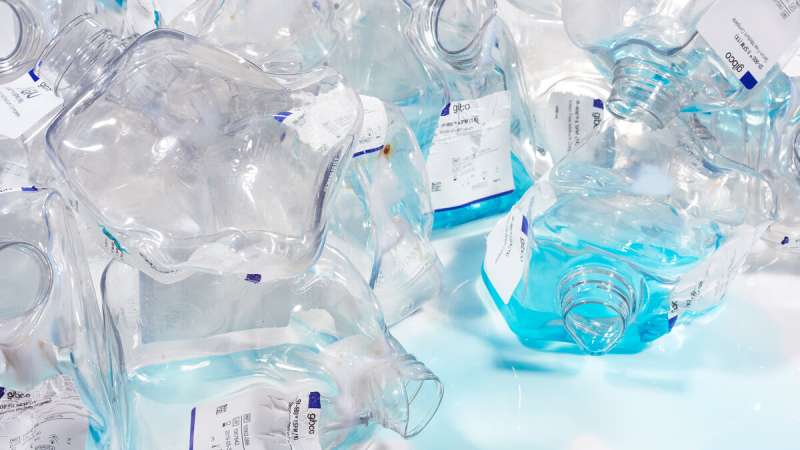Scientists, here's how to use less plastic

The lab is quietly bustling with scientists intent on their work. One gestures to an item on her bench—a yellow container, about the size of a novel. It's almost full to the brim with used plastic pipette tips—the disposable attachments that stop pipettes being cross-contaminated. She stares down at it, despondently. "And this is just from today."
We're at the Francis Crick Institute, a towering biomedical research facility in the heart of London. The scientist in question is Marta Rodriguez Martinez, a Postdoctoral Training Fellow. Every day in her lab, pipette tips, petri dishes, bottles and more are used and discarded. The scale of the waste is immense—research by the University of Exeter estimates that labs worldwide generate 5.5 million tonnes of plastic waste each year.
Alongside her research, Rodriguez Martinez doubles as a sustainability rep, tirelessly working to reduce the plastic waste her lab produces. The Crick's sustainability team consult her about the unique behaviors of scientists. In return, she encourages colleagues to stop using unnecessary plastic and teaches them about sustainable alternatives.
It's a difficult task, but one she feels passionate about. "We have in our heads that plastic is a one-use material, but it is not. Plastic can be autoclaved, it can be washed. Most plastics we use in the lab could be re-used as efficiently as glass."
The Crick is taking behavior change seriously. Alongside reps like Rodriguez Martinez, it offers sustainability workshops and waste training to employees. A pipette-tip audit is underway, which will show which products come with the lowest excess plastic. It's also developing an interactive dashboard for teams to see how their waste compares to other labs."
But behavior change is only the beginning. Rodrigo Ponce-Ortuño oversees the Crick's contract with an ecofriendly waste-management company. He points out that the journey of plastic lab equipment stretches far beyond its short service on the workbench.
Take media bottles—the plastic containers that hold nutrients to grow cells and bacteria. "It's just glucose that goes into the bottles," Ponce-Ortuño explains. The liquid is non-hazardous, but in his experience, recycling companies are wary of the scientific jargon on the labeling.
"If it just said sugar, it would be fine," he says. Instead, many companies reject the waste because they don't understand the chemistry. But, by using contractors with the right expertise, the Crick now sends all its media bottles for recycling.
For Rodriguez Martinez, this is a milestone. "I use maybe four media bottles a week, and there are 1,200 scientists here. That we can rinse them and have a contractor recycle them is a big success."
This tactic—of building companies' confidence in handling lab equipment—has led to other successes, too. Cooling gel packs, polystyrene boxes and the bulky pallets used to transport products are all collected for re-use. Boxes for pipette tips are also collected—after they've been stacked and re-used in the labs themselves.
In fact, the Crick's labs send no waste at all to landfill. Hazardous waste is safely incinerated, but anything else that can't be recycled goes through a process called energy-from-waste, where electricity, heat or fuel is harvested from the material as it's disposed of.
And they're just as keen to reduce the amount of plastic coming in. The institute recently held a green procurement fair, where suppliers had to meet a set of sustainability criteria to attend. "Normally when you buy a product, you look at the quality and the price," says Rodriguez Martinez. "We want to add sustainability to that equation."
The team know that change won't happen overnight. They need to win people over with practical measures to reduce plastics—without reducing the quality of science. So the institute is discussing best practice with other laboratories, to grow the movement for low-plastic research.
"We're trying to educate people into a more sustainable science," says Rodriguez Martinez.
Provided by Mosaic
This article first appeared on Mosaic and is republished here under a Creative Commons licence. 




















